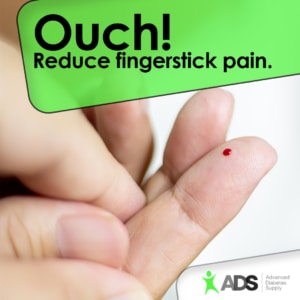
Diabetes management can be inconvenient, but it shouldn’t be excruciating. Here, you’ll find ADS’ advice on how you can cut down on pain related to fingerstick testing.
If you’ve been diagnosed with diabetes, blood sugar finger tests are part of your management. These tests can be annoying, but they also play a vital role in diabetes management. Testing your blood glucose level allows you to see whether or not your efforts to control your diabetes symptoms are paying off. If they aren’t, you can use this information to decide what to do next.
Unfortunately, there’s no way to eliminate the need for these inconvenient tests. However, you can still make life easier for yourself by keeping them as painless as possible. Keep reading for the information you need to know about reducing pain while testing blood sugar.
Use A Lancing Device
If you’re not already using a lancing device, picking one up is a great way to cut down on the pain associated with finger prick tests. These devices hold lancets, making it considerably easier to collect a blood sample when you need to test your glucose level. In most cases, you’ll use a lancing device by inserting a lancet, placing the device on your fingertip, and pushing a button.

When choosing a lancing device, there are a few factors that are worth considering:
- Compatible lancets
- Ability to adjust lancet depth
- What your healthcare covers
- Ease of use
- Size of devices
- Safety features for used lancet removal
Pick The Best Lancet For You
Choosing a lancing device that’s a good fit for your needs is crucial, but the other half of this process is selecting the right lancets to use along with it. One of the most significant decisions you’ll need to make is the gauge of your lancets. Bigger gauge numbers equal thinner needles – and less pain.
You’ll need to choose lancets based on the thickness of your skin. When you get started, it’s wise to go with lancets with thinner needles. Of course, you can always switch to thicker needles if you’re having trouble getting a good blood sample. Also, do not reuse lancets. Use a new lancet every time you test.
Try Testing The Sides of Your Fingers
Some parts of your fingers are more sensitive than others. If you’re having trouble dealing with the pain that comes with using a lancing device on your finger pads, switch to the sides of your fingertips. They have fewer nerve endings, so you might not feel as much pain there.
Get A Good Sample In One Try
If you remember a few tips before your next finger test, you’ll reduce the likelihood of needing to try more than once to get a decent blood sample:
- Shake your hands before thoroughly washing your fingertips. That way, blood will head to the tips of your fingers. Wash hands with soap and warm water.
- While cleaning your finger, rub the tip in a “milking” motion.
- Make sure your fingertip is warm before using your lancing device.
- Be sure to put your finger on a hard surface when collecting a blood sample.
Choose The Right Setting
Ideally, you shouldn’t have to change depth settings on your lancing device every time you need to do a finger prick test. With that in mind, it’s worth taking some time to figure out what setting works best for you.
When using a new lancing device, start with a lighter (and less painful) depth setting. If you’re able to get a sizable blood sample without squeezing your finger while using this setting, you’re in luck. Otherwise, increase your depth setting before your next blood glucose test and try again.
Rotate Testing Sites

When you’ve tested one of your fingers, there’s a good chance it will be sore for a while after. Instead of constantly testing in the same spot, you can cut down on pain considerably by rotating testing sites. An easy way to keep track of test sites is to outline your hand on a piece of paper. Put a dot at the location corresponding with your last test site, and try another spot the next time you need to check blood sugar.
Some glucose meters can also use blood samples from body parts other than the fingers, or alternate site testing. Work with your diabetes educator to learn whether the palm of your hand, an arm or thigh is a better option. It is crucial to ensure your meter has this capability first. Don’t rely on blood samples from alternate sites when your glucose levels may be rapidly changing, either.
Use Oil To Soothe Sore Fingers
In addition to changing your testing regimen, mixing up your skincare routine can make it easier to deal with finger prick-related pain. For example, try putting tea tree oil on your fingertips twice daily to reduce soreness. You can usually find this oil in pharmacies, and it’s easy to apply with a cotton swab.

Cut Down On Finger Prick Tests With CGMs
Of course, the most effective way to feel less pain from finger prick tests is to reduce your reliance on these tests in the first place. Until recent years, this was an impossibility for people with diabetes. However, continuous glucose monitoring (CGM) systems can allow you to track your glucose levels without fingersticks.*
We offer many different CGMs at ADS, including the FreeStyle Libre 2 system, the Dexcom G6, and the Eversense. We’re also a trusted supplier of “traditional” glucose meters and diabetes testing supplies!
*Use a blood glucose meter to confirm any highs or lows and when your symptoms do not match your sensor’s readings.
